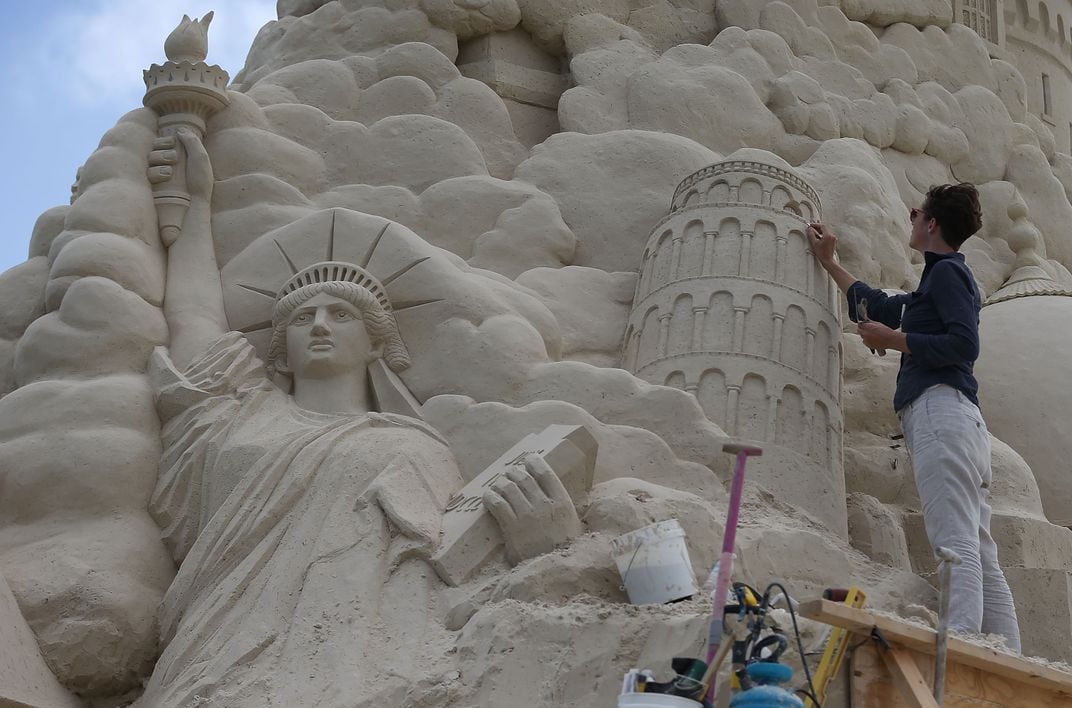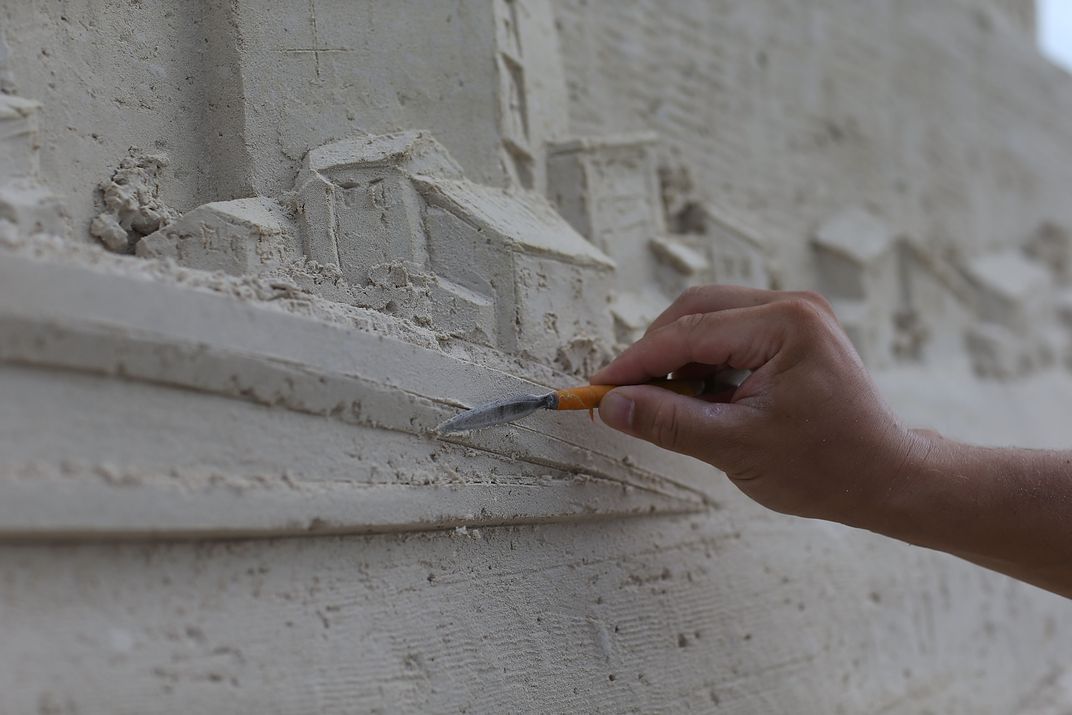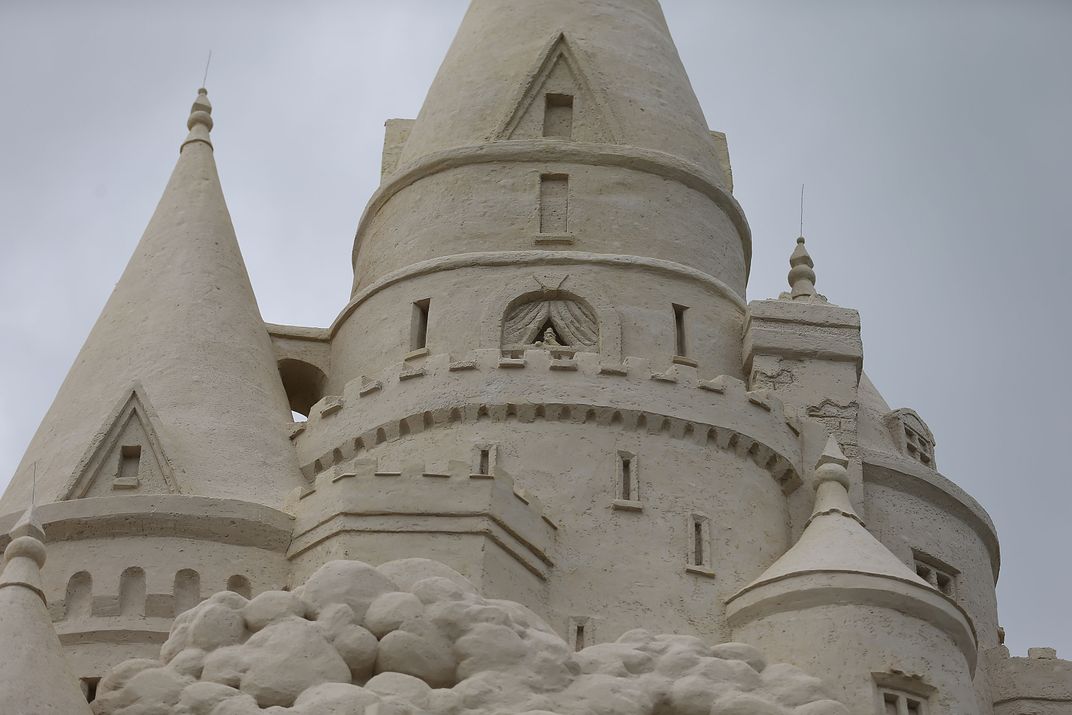How to Build a Sandcastle
World-record-holding sand sculptor Ted Siebert gives some tips for amateur builders looking to hone their skills this summer
/https://tf-cmsv2-smithsonianmag-media.s3.amazonaws.com/filer/aa/14/aa144270-9503-443c-be5f-5c6ba66d8a04/ted_siebert_sandcastle.jpg)
One might question the sanity of a 62-year-old man who spends weeks on end building sandcastles. After all, sandcastles are best known for keeping children occupied all day long on family beach vacations as they play in the soft, moldable substrate and toil away in creativity. But for the past 40 years, sand sculpting has occupied every waking moment of Ted Siebert’s professional life. The Illinois native made a name for himself on the sandcastle contest circuit as a teen with gobs of creative whimsy and technical mastery. His rise was well-timed: the eighties and nineties saw a boom in demand for sandcastle displays in malls and at public events across America. Businesses angling for a publicity blitz hired Siebert to construct towering, ornate structures for marketing campaigns.
As the prestige, and attendant budget, of his clients grew, so did the castles. In 2003, the world-record sandcastle height was 29 feet, set by a hobbyist in Maine with the help of a few friends and no machinery. Since then, the records have nearly doubled in height, and they can no longer be pulled off without multimillion-dollar backing from governments and large corporations. Siebert has held nine world records, including one set by a 2015 job in Key Biscayne, Florida, for Turkish Airlines, with 1,800 tons of sand piled 45 feet and 10.25 inches high, which has mostly survived several hurricanes. A 2013 job in Kuwait City used 30,000 tons of sand. This past February, his company built 14 horse sculptures to decorate an Arabian horse festival in Saudi Arabia using 2,000 tons of sand.

While most of Siebert’s sand sculptures are major construction projects, he believes that anyone can have fun making their own sandcastles this summer. “It’s a wonderful social distancing activity,” he says. “It’s outside and you typically don’t want to do it in the middle of an area with a ton of people, plus it’s a great way for anyone to exercise their creativity, which we all need right now.” Below, Siebert shares some tips for getting started.
Compaction
“It all starts with compaction of the sand to give it stability,” Seibert says. “That’s the absolute key and will preserve the structure in the long run.” By using a bucket of wet sand, Seibert is able to make a structure ten times firmer than just regular sand pushed together. “Water is a natural binder that creates surface tension,” he adds.
First, take a five gallon bucket and cut the bottom out with a utility knife, being careful not to slice your fingers in the process. Place the bucket upside down where you want your foundation and fill it about a third of the way with sand mixed with water from a second bucket. Slosh it around, and tamp the wet sand down with your fist. Keep adding more wet sand until the open bucket is full, then smack the sides of the bucket once or twice to break the seal and it should lift right off. Wet sand bonded to wet sand will stay strong for a while. Repeat this process, stacking the cylinders of sand right next to each other, until the base of your sandcastle is about as wide as you want it to be tall, then begin stacking more cylinders on top of the lower ones . Building close to the water is ideal as it makes it easier to lug buckets of water back and forth, but be mindful of the tide and waves that will eventually encroach on your castle.

Tools
In addition to your two buckets, you’ll want a palette knife to carve with, a straw to blow the excess sand away from your carving details and a paintbrush to smooth out any rough spots. You can also bring a comb or an angel food cake cutter or anything with teeth to add some texture to negative space by running it across the smooth walls in straight or swirly lines, and spray bottles can help you wet small areas and give the sand some extra stability to allow you to put some dimensional shapes and figures into it. “Pretty much everything you need can be found in your kitchen,” Siebert says.
Shapes
“The safest shape is obviously a pyramid,” Siebert says. “Even sculptures that look like tall, beautiful towers all have to be supported by a base that’s wider than the top.” Using the bucket loads of compacted sand stacked on top of one another in layers, Siebert suggests blocking out a rough shape before shaving sand off the upper sections and detailing it downwards from the top, carving towers and battlements out of the dense block.

A cone-shaped feature, like the top of a turret, is one of the simplest to add, according to Siebert. On the top of your block of sand, first draw a circle. Cut the sand back around this circle to form a cylinder shape. Mark the center point on the circle with a toothpick or nail and then, using a small level to be precise, draw a horizontal line at the bottom of your cone. Next, it’s just a matter of removing the sand from the center point to the line on the outside of the cylinder. “It of course takes practice," Siebert says.
If you start detailing too low, the structure is more likely to collapse. But don’t worry, sculptures don’t usually tip over right away—most will crack first. When you see cracking, push some sand up against the base to make it stronger. You can also take some weight off the top to avoid a total collapse and having to start all over, which is bound to happen sooner or later. Surrender to this reality ahead of time and it won’t be as painful when it happens.
On the professional competition circuit, in order to officially be considered a sandcastle, the height of a structure must be taller than the width of the base. Siebert likes this aesthetic and sees it as something worth aspiring to.
Shadows
“One of the key things about sand sculpting is that it’s the shadows you’re trying to attain,” says Siebert. “Little details can cast shadows in the right light and that’s always the money shot that looks really good.” You don’t want to be photographing your sandcastle in direct sunlight, so avoid starting too early because it’s going to look best in the evening golden hour anyway.

Another shadowing technique Siebert loves is framing a shape or figure within a darker exterior such as a window or cave. Try to carve a fish or something that’s swimming through some rocks or a hole. The setback sand will look darker than the sand in front of it and give it much more definition. Sometimes you can put a small mirror inside a castle window to give off a reflection that looks like you can see right through it. Be creative yet careful, carving out little bits at a time to avoid taking out large chunks.
Also, go crazy with drip castles. Grab handfuls of wet, saturated sand and let it drip from your fingertips until they build up like stalagmites. Those add a smattering of small shadows and texture to the overall castle.
Make Mistakes
Don’t be afraid to take risks with sand. Siebert believes that sand is the best medium to practice your sculpting skills because it goes up fast on a large scale, you can fix just about anything, and if you don’t like how your castle turns out, you can quickly start all over again once it collapses. So go for it!